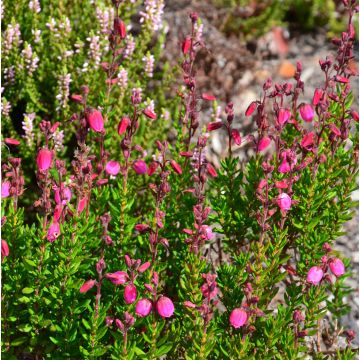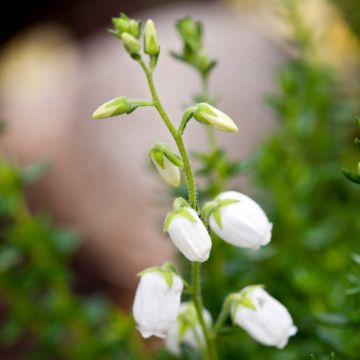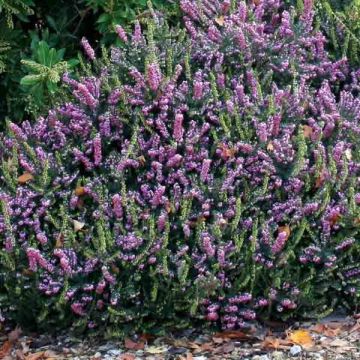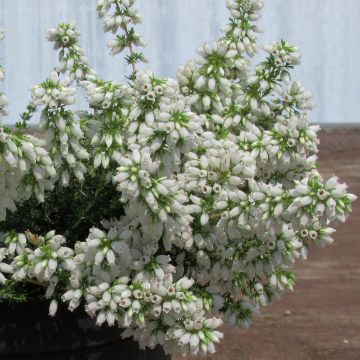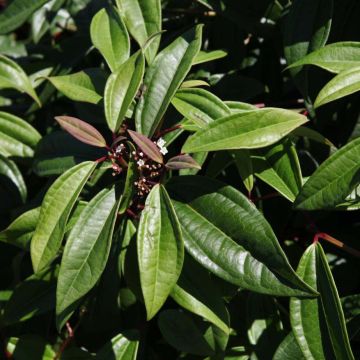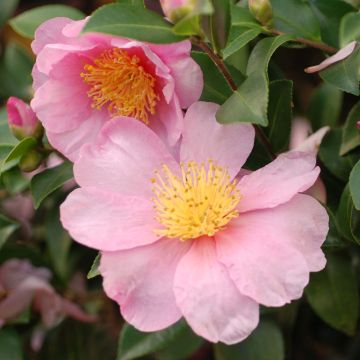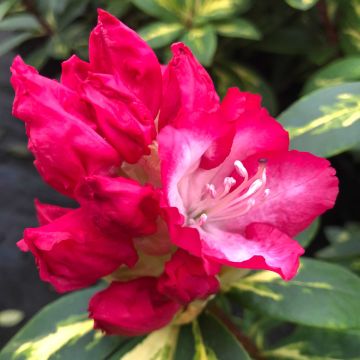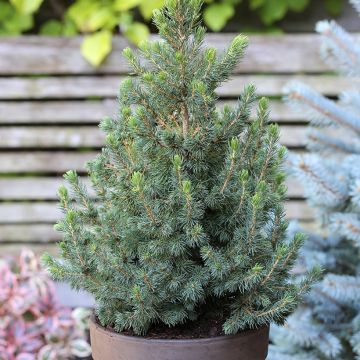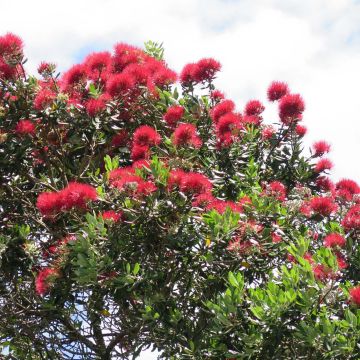

Erica terminalis - Corsican Heath


Erica terminalis - Corsican Heath


Erica terminalis - Corsican Heath
Erica terminalis - Corsican Heath
Erica terminalis
Corsican Heath
This item cannot be shipped to the selected country
Delivery charge from €5.90
More information
Schedule delivery date,
and select date in basket
This plant carries a 24 months recovery warranty
More information
We guarantee the quality of our plants for a full growing cycle, and will replace at our expense any plant that fails to recover under normal climatic and planting conditions.
From €5.90 for pickup delivery and €6.90 for home delivery
Express home delivery from €8.90.
Does this plant fit my garden?
Set up your Plantfit profile →
Description
Erica terminalis is a species native to Corsica and the Mediterranean region where it spontaneously grows in cool ravines with Alnus viridis and A. suavelons. It is one of the hardiest heathers with the best limestone tolerance. It thrives in well-drained and dry soils, in full sun or partial shade. It forms a densely branched bush with an upright, rounded habit and its branches are covered with tiny, linear, shiny dark green leaves, arranged in whorls of 3 or 6, which persist all year round. From July to August, it bears terminal clusters of bell-shaped flowers, 8 mm (0.3 in) in size, pale pink to mauve, fragrant and extremely nectar-rich. The flowers then turn into intense coppery orange, remaining decorative until winter. With medium growth, it reaches a height of 1.2 m (3 ft 11 in) and a width of 1 m.
Hardy down to -20°C (-4 °F) and undemanding of soil type as long as it is dry and well-drained, it is a sturdy, small bush, ideal for coastal gardens, and natural-style dry gardens. Its dense habit and size make it suitable for forming low, evergreen hedges or adding colour to wilder spaces such as slopes and rockeries. This large heather can be combined with shorter species and varieties that flower at the same time in various colours: Erica carnea or darleyensis offer blooms ranging from pure white to purple-violet, as well as all shades of pink and red in winter and spring. It can also be paired with shrubby veronicas (Hebe), small-sized Pittosporum (Pittosporum tenuifolium Tom Tumb), Viburnum fragrans, dwarf hollies, or Chimonanthus praecox. In a naturalistic garden, this heather can create an extremely romantic scene when planted in groups of 3 to 5, at a time when flowering is scarce.
Report an error about the product description
Erica terminalis - Corsican Heath in pictures
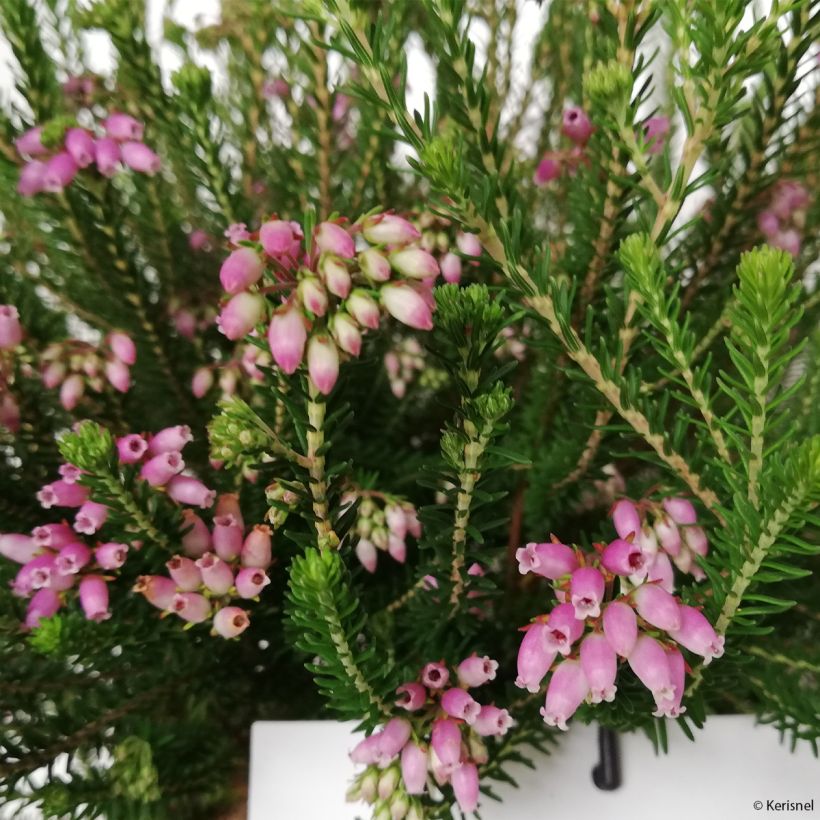





Plant habit
Flowering
Foliage
Botanical data
Erica
terminalis
Ericaceae
Corsican Heath
Mediterranean
Other Heather
Planting and care
Erica terminalis appreciates full sun, which intensifies its flowering, and can grow in any type of soil, even clayey or limestone, as long as it is well-drained. Once well-established, it can withstand a lot - heat, drought, cold down to -20°C (-4 °F), and even sea spray. However, it cannot tolerate waterlogged soil at all, especially in hot weather, as it can promote the development of a fungus called Phytophthora, which, once established, will kill this heather.
To maintain a compact habit and increase the lifespan of the heather, it is useful to cut back the faded branches to 2-5 cm (0.8-2 in) from the previous year's growth every year after flowering, making sure never to prune below the last green leaves. Erica can also be susceptible to phythium and rhizoctonia during hot and humid periods. Fertilizer is not necessary, and is even discouraged, in order not to promote foliage production at the expense of flowering (heathers are generally plants of poor soils).
Planting period
Intended location
Care
-
, onOrder confirmed
Reply from on Promesse de fleurs
Evergreen shrubs
Haven't found what you were looking for?
Hardiness is the lowest winter temperature a plant can endure without suffering serious damage or even dying. However, hardiness is affected by location (a sheltered area, such as a patio), protection (winter cover) and soil type (hardiness is improved by well-drained soil).

Photo Sharing Terms & Conditions
In order to encourage gardeners to interact and share their experiences, Promesse de fleurs offers various media enabling content to be uploaded onto its Site - in particular via the ‘Photo sharing’ module.
The User agrees to refrain from:
- Posting any content that is illegal, prejudicial, insulting, racist, inciteful to hatred, revisionist, contrary to public decency, that infringes on privacy or on the privacy rights of third parties, in particular the publicity rights of persons and goods, intellectual property rights, or the right to privacy.
- Submitting content on behalf of a third party;
- Impersonate the identity of a third party and/or publish any personal information about a third party;
In general, the User undertakes to refrain from any unethical behaviour.
All Content (in particular text, comments, files, images, photos, videos, creative works, etc.), which may be subject to property or intellectual property rights, image or other private rights, shall remain the property of the User, subject to the limited rights granted by the terms of the licence granted by Promesse de fleurs as stated below. Users are at liberty to publish or not to publish such Content on the Site, notably via the ‘Photo Sharing’ facility, and accept that this Content shall be made public and freely accessible, notably on the Internet.
Users further acknowledge, undertake to have ,and guarantee that they hold all necessary rights and permissions to publish such material on the Site, in particular with regard to the legislation in force pertaining to any privacy, property, intellectual property, image, or contractual rights, or rights of any other nature. By publishing such Content on the Site, Users acknowledge accepting full liability as publishers of the Content within the meaning of the law, and grant Promesse de fleurs, free of charge, an inclusive, worldwide licence for the said Content for the entire duration of its publication, including all reproduction, representation, up/downloading, displaying, performing, transmission, and storage rights.
Users also grant permission for their name to be linked to the Content and accept that this link may not always be made available.
By engaging in posting material, Users consent to their Content becoming automatically accessible on the Internet, in particular on other sites and/or blogs and/or web pages of the Promesse de fleurs site, including in particular social pages and the Promesse de fleurs catalogue.
Users may secure the removal of entrusted content free of charge by issuing a simple request via our contact form.
The flowering period indicated on our website applies to countries and regions located in USDA zone 8 (France, the United Kingdom, Ireland, the Netherlands, etc.)
It will vary according to where you live:
- In zones 9 to 10 (Italy, Spain, Greece, etc.), flowering will occur about 2 to 4 weeks earlier.
- In zones 6 to 7 (Germany, Poland, Slovenia, and lower mountainous regions), flowering will be delayed by 2 to 3 weeks.
- In zone 5 (Central Europe, Scandinavia), blooming will be delayed by 3 to 5 weeks.
In temperate climates, pruning of spring-flowering shrubs (forsythia, spireas, etc.) should be done just after flowering.
Pruning of summer-flowering shrubs (Indian Lilac, Perovskia, etc.) can be done in winter or spring.
In cold regions as well as with frost-sensitive plants, avoid pruning too early when severe frosts may still occur.
The planting period indicated on our website applies to countries and regions located in USDA zone 8 (France, United Kingdom, Ireland, Netherlands).
It will vary according to where you live:
- In Mediterranean zones (Marseille, Madrid, Milan, etc.), autumn and winter are the best planting periods.
- In continental zones (Strasbourg, Munich, Vienna, etc.), delay planting by 2 to 3 weeks in spring and bring it forward by 2 to 4 weeks in autumn.
- In mountainous regions (the Alps, Pyrenees, Carpathians, etc.), it is best to plant in late spring (May-June) or late summer (August-September).
The harvesting period indicated on our website applies to countries and regions in USDA zone 8 (France, England, Ireland, the Netherlands).
In colder areas (Scandinavia, Poland, Austria...) fruit and vegetable harvests are likely to be delayed by 3-4 weeks.
In warmer areas (Italy, Spain, Greece, etc.), harvesting will probably take place earlier, depending on weather conditions.
The sowing periods indicated on our website apply to countries and regions within USDA Zone 8 (France, UK, Ireland, Netherlands).
In colder areas (Scandinavia, Poland, Austria...), delay any outdoor sowing by 3-4 weeks, or sow under glass.
In warmer climes (Italy, Spain, Greece, etc.), bring outdoor sowing forward by a few weeks.

































